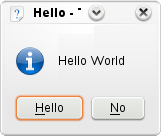Development/Tutorials/First program/nl
| Tutorial Series | Beginner Tutorial |
| Previous | C++, Qt, Building KDE |
| What's Next | Tutorial 2 - KXmlGuiWindow |
| Further Reading | n/a |
Samenvatting
Wat zou je eerste programma anders moeten doen dan de wereld begroeten? Om dat voor elkaar te krijgen, gebruiken we een KMessageBox en passen we één van de knoppen aan.



De code
Alle code die we nodig hebben, komt in één bestand te staan: main.cpp. Maak dat bestand en zet de volgende code erin:
#include <cstdlib>
#include <KApplication>
#include <KAboutData>
#include <KCmdLineArgs>
#include <KMessageBox>
#include <KLocale>
int main (int argc, char *argv[])
{
KAboutData aboutData(
// The program name used internally.
"tutorial1",
// The message catalog name
// If null, program name is used instead.
0,
// A displayable program name string.
ki18n("Tutorial 1"),
// The program version string.
"1.0",
// Short description of what the app does.
ki18n("Displays a KMessageBox popup"),
// The license this code is released under
KAboutData::License_GPL,
// Copyright Statement
ki18n("(c) 2007"),
// Optional text shown in the About box.
// Can contain any information desired.
ki18n("Some text..."),
// The program homepage string.
"http://example.com/",
// The bug report email address
"[email protected]");
KCmdLineArgs::init( argc, argv, &aboutData );
KApplication app;
KGuiItem yesButton( i18n( "Hello" ), QString(),
i18n( "This is a tooltip" ),
i18n( "This is a WhatsThis help text." ) );
return
KMessageBox ::questionYesNo
(0, i18n( "Hello World" ), i18n( "Hello" ), yesButton )
== KMessageBox ::Yes? EXIT_SUCCESS: EXIT_FAILURE;
}
The first KDE specific code we come across in this program is KAboutData. This is the class used to store information about the program such as a short description, authors or license information. Pretty much every KDE application should use this class.
Dan komen we bij de KCmdLineArgs. Deze klasse wordt gebruikt om opdrachtprompt-opties aan te geven, bijvoorbeeld om het programma te openen met een bepaald bestand. In deze tutorial echter initialiseren we het met het KAboutData-object dat we gemaakt hebben, zodat we de opties --version en --author kunnen gebruiken.
Daarna maken we een KApplication aan. Dit moet in een programma precies één keer gedaan worden, want het wordt gebruikt voor dingen als vertalingen.
We zijn nu klaar met alle nodige KDE-instellingen, en we kunnen verdergaan met interessantere dingen. We maken een popup, maar daarbij passen we één van de knoppen aan. Om deze wijziging aan te brengen, moeten we een KGuiItem-object gebruiken. Het eerste argument in de constructor van KGuiItem is de tekst die op het item komt te staan (in ons geval dus de knop). Dan hebben we een optie om een icoontje op de knop te zetten; dat willen we niet en dus geven we alleen een QString() mee. Dan stellen we de tooltip in (de tekst die verschijnt als je met de muis boven een item hangt) en ten slotte de "Wat is dit?"-tekst (die je krijgt door met de rechtermuisknop te klikken of op Shift-F1 te drukken).
We hebben nu een item, en nu kunnen we de popup aanmaken. We roepen de functie KMessageBox::questionYesNo() aan, die een venster met een "Ja"- en een "Nee"-knop maakt. Het tweede argument is de tekst die verschijnt in het venster, boven de knoppen. Het derde is de venstertitel, en ten slotte stellen we als KGuiItem de aangemaakte KGuiItem yesButton in voor de (oorspronkelijke) "Ja"-knop.
Merk op dat we alle tekst die zichtbaar is voor de gebruiker door de i18n()-functie sluizen. Dat is nodig om de interface vertaalbaar te maken. Meer informatie over vertaling kun je vinden in de tutorial over vertaling.
We zijn klaar met de code; laten we het programma compileren en uitproberen.
Compilatie
Je kunt het beste CMake gebruiken als compileeromgeving. Je maakt een bestand CMakeLists.txt, en cmake gebruikt dit bestand dan om alle Makefiles te genereren.
CMakeLists.txt
Create a file named CMakeLists.txt in the same directory as main.cpp with this content:
project (tutorial1)
find_package(KDE4 REQUIRED)
include (KDE4Defaults)
include_directories(${KDE4_INCLUDES})
set(tutorial1_SRCS main.cpp)
kde4_add_executable(tutorial1 ${tutorial1_SRCS})
target_link_libraries(tutorial1 ${KDE4_KDEUI_LIBS})
install(TARGETS tutorial1 ${INSTALL_TARGETS_DEFAULT_ARGS})
The find_package() function locates the package that you ask it for (in this case KDE4) and sets some variables describing the location of the package's headers and libraries. In this case we will use the KDE4_INCLUDES variable which contains the path to the KDE4 header files.
In order to allow the compiler to find these files, we pass that variable to the include_directories() function which adds the KDE4 headers to the header search path.
Next we create a variable called tutorial1_SRCS using the set() function. In this case we simply set it to the name of our only source file.
Then we use kde4_add_executable() to create an executable called tutorial1 from the source files listed in our tutorial1_SRCS variable. Afterwards, we link our executable to the KDE4 kdeui library using target_link_libraries() and the KDE4_KDEUI_LIBS variable which was set by the find_package() function. The line starting with install writes a default "install" target into the Makefile.
Make And Run
To compile, link and install your program, you must have several software installed, e.g. kdelibs, cmake, make and gcc-c++. To be sure you have everything, best follow this install guide.
You can invoke CMake and make manually:
cmake . && make && make install
Or, if you set up your environment as described in Getting Started/Build/Environment, you can compile this code with:
cmakekde
And launch it with:
./tutorial1
Moving On
Now you can move on to using KXmlGuiWindow.
